Table of Contents
Introduction
The Naxalites or Naxals are a group of far-left radical communists. They are regarded as one of the most dreaded terror groups within India. They are part of an organization that once stood for the weaker sections of the society and against their exploitation. Today, their objective has deviated. The Naxals have been involved in unlawful activities like terror attacks, money extortion, illegal occupation, etc.
When we talk about Naxalites, their roots are associated with the Communist Party of India (Marxist) or CPI(M). The party was later split to form the Communist Party of India (Marxist-Leninist) or CPI(ML). From CPI(ML), several groups were formed and one of the groups was CPI(Maoist). Today, when we relate to Naxalites, they are majorly part of this group.
CPI(Maoist) was regarded as a terror outfit under the Unlawful Activities (Prevention) Act in 2009.
Before delving into the history of Naxalites, it is important to talk about the terms: Marxism, Leninism, and Maoism. These are explained in the following section in a very simple way. Treat them as insightful facts or skip them if you already have an idea.
Marxism, Leninism, and Maoism
Bourgeoisie and Proletariat
As per the Marxist theory, Bourgeoisie is a French term that refers to the social class. The Social Class owns the means of production (private ownership). This class of people is focused on their personal good and exploiting the lower labor class.
The Proletariat is the labor class (wage earners) that works (does not own means of production) for and is exploited by the Bourgeoisie.
Marxism
Marxism is a social, political, and economic theory that was developed in the 19th century. It was the brainchild of the German philosopher Karl Marx and to a certain extent contributed by Friedrich Engels. Karl Marx is generally known for his “Conflict Theory” in Sociology.
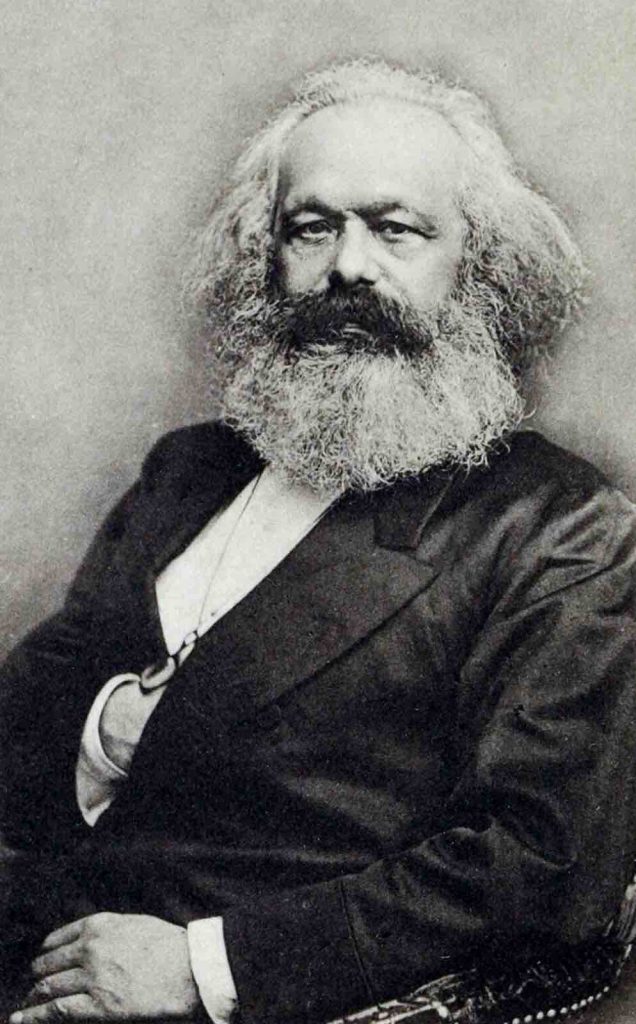
Courtesy – Britannica
However, Marx was drawn to the question of freedom and how humans can be considered free. Due to the rise of feudalism and other anti-labor laws, society was getting divided into a higher(owner) class of people who owned the means of production and the labor class that worked under the owner class. This created social inequality as the owner class exploited the labor class by making them work more and pay less.
Marxism is considered to be the opposite of the theory of Capitalism. In Capitalism, the means of production are owned by private institutions rather than the community/state as a whole.
Marxism shifts to the ideology where the means of production and ownership are in the hands of the Proletariat collectively rather than private owners or the Bourgeoisie. The main objective of the ideology is to abolish any form of inequality. As per Marx, this kind of ideology/revolution can take place only in countries where Capitalism (Industrialization) is at its peak.
Leninism
Leninism (also called Marxism-Leninism) is seen as a form of Marxism that was created by Vladimir Lenin. It is associated with the idea of creating a Vanguard party (as opposed to Marxism where the core idea was to bring the revolution by the working class collectively) that would lead the revolution for the working class.
Marxism-Leninism aimed to transform a Capitalist state into a one-party Socialist state and to create a Proletariat dictatorship.
Leninism was implemented in Russia (then USSR) where Lenin ended the centuries-old domination of Tsars. He created his form of dictatorship in the region.
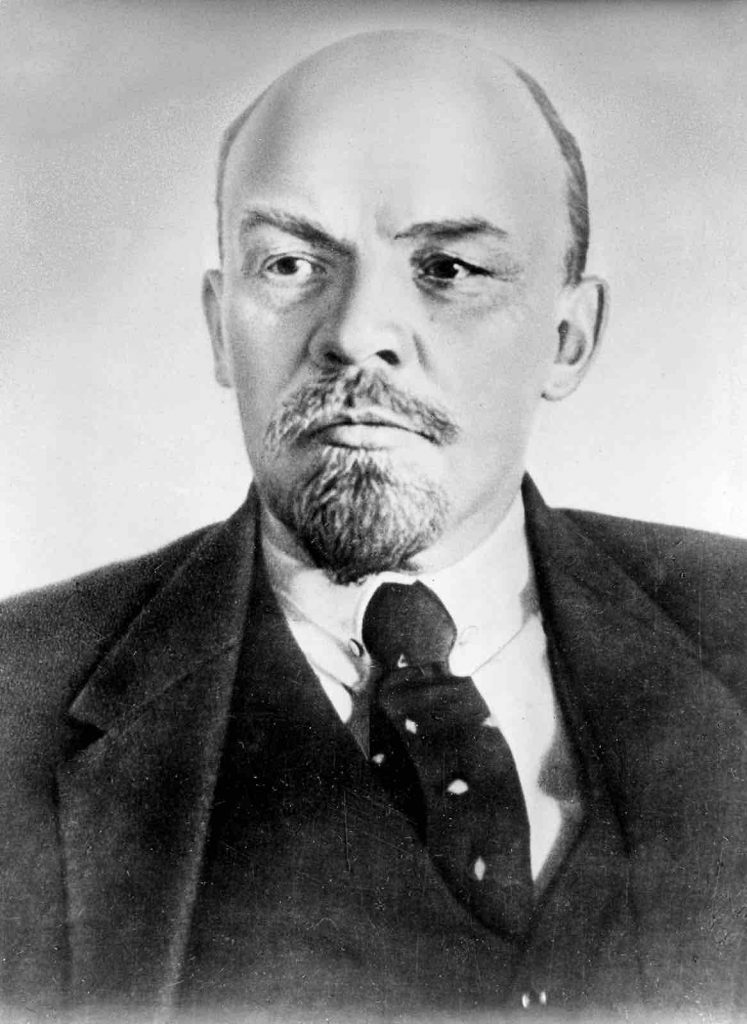
Courtesy – Britannica
As per Stalin, “Marxism is the science of the laws governing the development of nature and society, the science of the revolution of the oppressed and exploited masses, the science of the victory of socialism in all countries, the science of building a communist society.”
Stalin supported and developed Marxism-Leninism after Lenin’s death.
Maoism
Maoism is also a form of Marxism-Leninism but differs a bit. The philosophy is related to Proletariat who are peasants rather than labor or daily wage workers. It was the philosophy of Mao Tse-tung or Mao Zedong, who was a communist revolutionary. He fought against imperialism and also brought the Proletariat (peasants) revolution to China which was then an agrarian society.
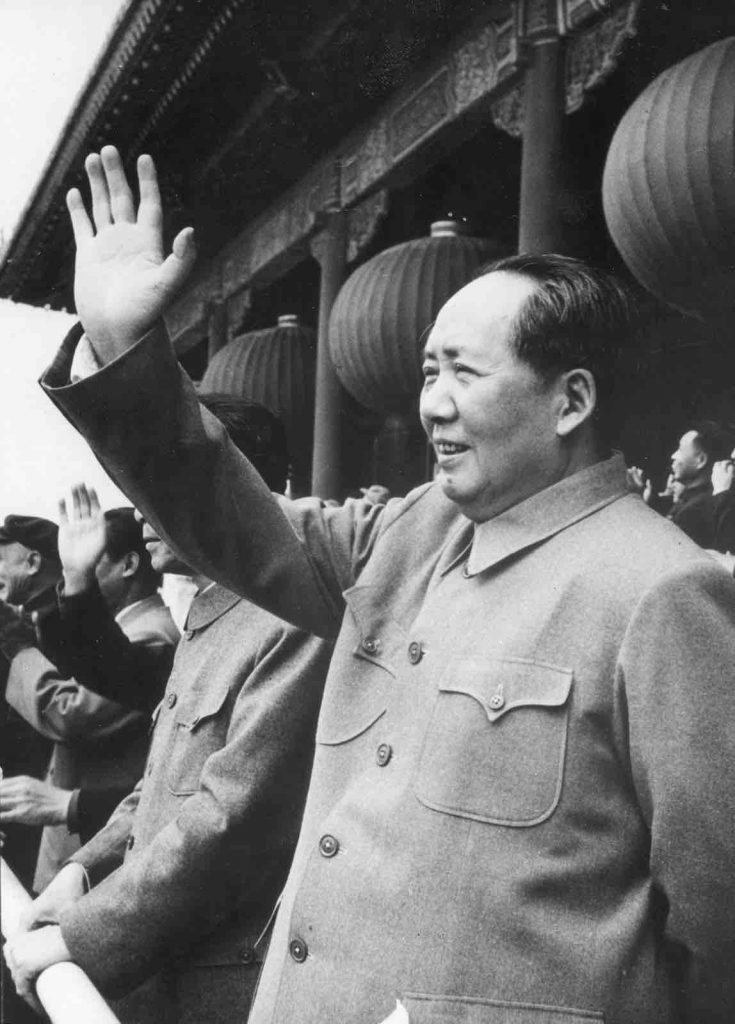
Courtesy – Britannica
As per Marxism-Leninism, the peasants are not capable enough to be a part of the working-class proletariat revolution. Mao did not approve of this theory. He considered peasants capable enough to bring about a change even through violence if necessary as they were fueled by poverty and exploitation.
Socialism and Communism
Both Socialism and Communism are part of the larger Marxism ideology.
Socialism is an ideology where means of production are controlled by the community (or democratic state) rather than by private companies. This also includes the distribution and exchange of goods. In socialism, everyone contributes to the greater good of the community/state and then shares an equal amount of revenue among each other.
Communism is an ideology that is considered to be the next step of Socialism where all the aspects of society including the economy and means of production are owned by the community/state. As a result, this eliminates the idea of private ownership and the higher class exploiting the lower labor class. Communism aims to create an “equal” society where everyone works for the greater good of society and takes only what they need or deserve.
Considering the definition of Communism, there has never been a pure Communist country to date.
Communist Party of India (CPI)
The Communist Party of India (CPI) is a national and one of the oldest communist parties in India. It was formed in 1925 as a result of the rise of Marxism-Leninism.
CPI was formed by a few patriotic youths with the intention of overthrowing the British Imperialistic regime. The root of the formation of the Communist Party of India was the Great October Socialist Revolution in Russia which was initiated by the Bolsheviks party under the leadership of Vladimir Lenin, the founder of the theory of Leninism.
Communist Party of India follows the Marxism-Leninism ideology.
The formation of the All India Trade Union Congress in 1920 is considered an important laying stone for the formation of the CPI. It was formed to address the grievances of the worker class and peasants by uniting and taking part in the struggle for independence from the atrocities of the imperialists. Anti-imperialist boycotts and anti-lordship strikes were the highlights of the Union.
Non-cooperation Movement
The “Non-cooperation Movement” in India was the other major event that instigated Indian youth to raise their voice against the British Raj. This included workers, peasants, the middle class, and students. It is said that many militant youths were born out of this movement.
The need to create CPI arose when the Non-cooperation Movement was withdrawn. The youth needed some motivation to keep their objective burning and the October Revolution became their motivation. The youth embraced Marxism and Leninism as a tool for revolution. It was also a way forward to free India from British rule.
It was at this time that the believers of anti-imperialistic values came together and formed the Communist Party of India in Kanpur in December of 1925. CPI consisted of youths who believed in the militant struggle against the British Imperialists (and the landlords and the native rulers who supported British rule) and establishing the idea of socialism and communism in the country.
As per the CPI’s official website:
“The CPI was born out of the fusion of militant anti-imperialist patriotism and internationalism, of the struggle for national liberation and the class struggle for socialism.
Land to the tiller! Nationalization of foreign imperialist capitalists! Adult suffrage! The nation’s wealth in the nation’s hands! 8-hour working day! Democratic rights of organization, meeting, demonstration and strike! Social equality for women! Social justice for the untouchables! – these and other demands which were destined to become national demands, first resounded after 1925 from the ranks of the CPI.”
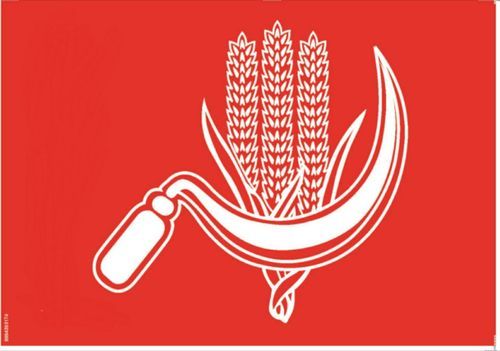
Courtesy – ElectionMS
Post-Independence, CPI has been involved in bringing the state administration and people closer. They stand for tribal rights, backward classes, the poor, and the oppressed.
Today, CPI has a significant presence in the states of Kerala, West Bengal, Andhra Pradesh, and Punjab.
Communist Party of India (Marxist)
The Communist Party of India (Marxist) or CPI(M) was formed out of the Communist Party of India at its Seventh Congress held in 1964. It is a national party just like the CPI.
The separatist ideology was born within the CPI when a faction decided to let go of the idea of armed struggle and work within the parliamentary system. The heart of the CPI was the armed struggle. While one faction of the party was inclined towards the political spectrum, the other faction insisted on the fact that the feudal system was still part of India and an armed struggle was required.
As a result, two factions emerged out of CPI. One was the “right-wing” that joined hands with the Indian National Congress, the biggest political party in India, and embraced the idea of revisionism and sectarianism. This philosophy of “right-wing” was considered to be anti-unity and anti-communism by the “left-wing”.
The other faction “left-wing” maintained the philosophy of mass line created by Mao Zedong (as part of the Chinese Communist Party (CCP)) in China.
Mass Line is a political, organizational, and leadership method where the idea is to consult the masses, take their suggestions, and finally implement them.
Differences in CPI
It is said that the differences between the two factions grew so much that many CPI “left-wing” leaders were arrested due to the conspiracy by the “right-wing” leaders in collaboration with Indian National Congress.
Later, the faction of CPI with the “left-wing” ideology created the Communist Party of India (Marxist).
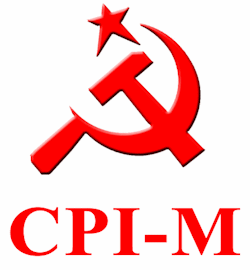
Courtesy – GlobalSecurity.org
The ideology of CPI(M) is similar to that of the undivided CPI that was formed in 1925. While the current CPI has softened its earlier stance, CPI(M) still firmly believes in the idea of Marxism and Leninism. The party is supported by the worker class, farmers, agriculture laborers, etc.
Consequently, CPI(M) is critical of the new policies that are implemented to promote the influx of foreign goods. As per CPI(M), this is against the theory of Marxism-Leninism. CPI(M) is engaged in bringing about transformation for the proletariat and in fighting against the imperialist, bourgeois, and landlord exploitation.
Today, CPI(M) has a significant presence in the states of Kerala, West Bengal, and Tripura.
Communist Party of India (Marxist-Leninist)
In 1969, a split happened within the Communist Party of India (Marxist) and another party Communist Party of India (Marxist-Leninist) or CPI(ML) came into existence. The party was formed by the All India Coordination Committee of Communist Revolutionaries (AICCCR) which was a splinter group formed out of the Communist Party of India (Marxist) in 1967.
The primary reason why CPI(ML) was formed was because of the inclination of some of the leaders of CPI(M) to enter the political spectrum and joining hands with the other political parties. However, radicals of CPI(M) accused the party leaders of forgetting the very core of the ideology of Marxism-Leninism and slowly shifting towards revisionism. CPI(ML) while rejecting the idea of the electoral process resorted to the armed struggle.
Later, due to differences, CPI (ML) was split into two, one led by Satyanarayan Singh and the other by the top leader, Charu Majumdar. In years to come, the parties further disintegrated into multiple splinter groups due to disagreements. Thus, what started as a unified fight ended with multiple individual factions. Today, there are over 20 organizations/groups that have emerged from CPI(ML).
The political party “CPI (ML) Liberation” emerged from CPI (ML). The party was formed out of anti-Lin Bao faction of Charu Majumdar’s CPI (ML). The party is prominent in Bihar and Jharkhand with its members in the state legislative assemblies.
Naxalites
Naxalite is the name given to a person who associates himself/herself with the Communist Party of India (Marxist-Leninist). Naxalites are generally a part of any of the splinter groups that originated from CPI(ML) and who believe in the armed struggle for the weaker sections of society.
Today, most of the Naxalites associate themselves with the Communist Party of India (Maoist) that has been declared a terror organization and the foremost internal threat to the country.
The name “Naxalite” comes from the uprising that took place in 1967 in the village of Naxalbari in West Bengal.
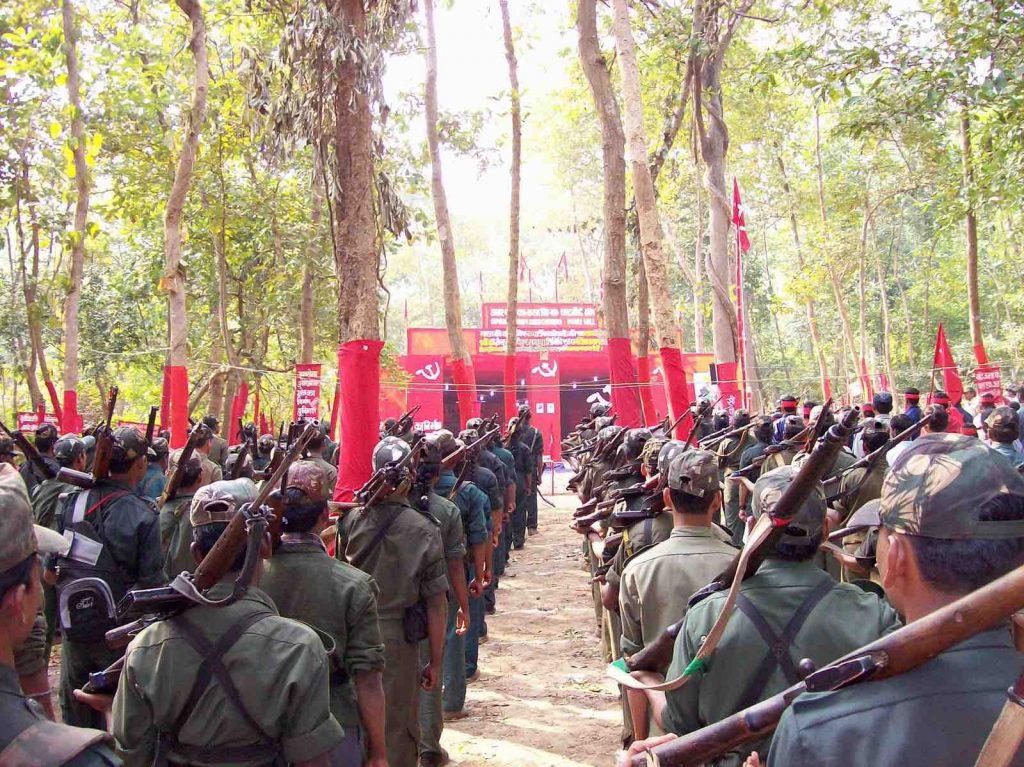
Courtesy – Redspark
In 1967, an armed struggle (Naxalbari uprising) was initiated by the faction of the CPI(M) that still maintained the idea of armed struggle. The primary objective of the struggle was to redistribute the land from the landlords to the peasants.
The Naxalbari uprising began when a tribal sharecropper was ill-treated and attacked by the landlords over some land dispute. The incident instigated a major uprising among peasants, tea plantation workers, and tribals. A large number of poor and exploited people united as part of the revolt and initiated attacks on the landlords. The uprising also included ambush attacks on policemen and other counter units.
Popularly, the communism struggle is said to have originated in independent India in 1948 in the Telangana region where the peasants united against the atrocities of the feudal lords. The far-leftist idea of Maoism and armed struggle had already penetrated the lower sections of society.
Armed Struggle
It was only two decades later that a full-fledged armed struggle began with the incident of Naxalbari. Post the formation of CPI(M), a faction of the organization started promoting the armed struggle against the indifferent upper class. The faction was heavily influenced by Mao Zedong’s philosophy of “protracted people’s war”. As a result of the struggle, People’s Courts were established that gave immediate judgments and even performed executions.
Over a period of time, while one faction of CPI(M) joined hands with the government and disapproved of the armed uprising, the other faction continued with the armed struggle. This faction was later expelled from the party and led to the creation of All India Coordination Committee of Communist Revolutionaries (AICCCR) and CPI(ML) in 1967 and 1969 respectively. The creation of these groups was fused with violent protests and uprisings in various parts of the country.
Communist Party of India (Maoist)
The Communist Party of India (Maoist) is a communist party in India that follows Maoism principles. Currently, it has been designated as a terror outfit due to its philosophy, guerilla warfare, and terror-based activities. The party aims to topple the government of India using the “protracted people’s war”, a strategy defined by Mao Zedong. The party was formed in 2004 by the merger of two groups: Communist Party of India (Marxist-Leninist) People’s War (or People’s War Group (PWG)) and Maoist Communist Center of India.
People’s War or Protracted People’s War is a military strategy developed by Mao Zedong. It says that a long enough support of people is required to support guerilla warfare and keep the war alive. The idea behind this strategy is to confine the enemy in the countryside and depleting them of resources thereby incapacitating them.
The PWG was founded in 1980 and worked primarily in the Telangana region. The party followed the ideology of Marxism-Leninism-Maoism, later invested in armed struggle, and rejected the idea of the electoral process. The party later extended its roots in the states of Andhra Pradesh, Orrisa, Madhya Pradesh, and Maharashtra. In 2004, the party was banned and designated as a terrorist organization.
The Maoist Communist Center of India (MCC or MCCI) was the name given to a group that emerged from CPI(ML) but maintained a separate Maoist ideology of mass mobilization, armed struggle, and guerilla warfare. This group was initially called Dakshin Desh. The group consisted of primarily tribals and Dalits and majorly operated in West Bengal.
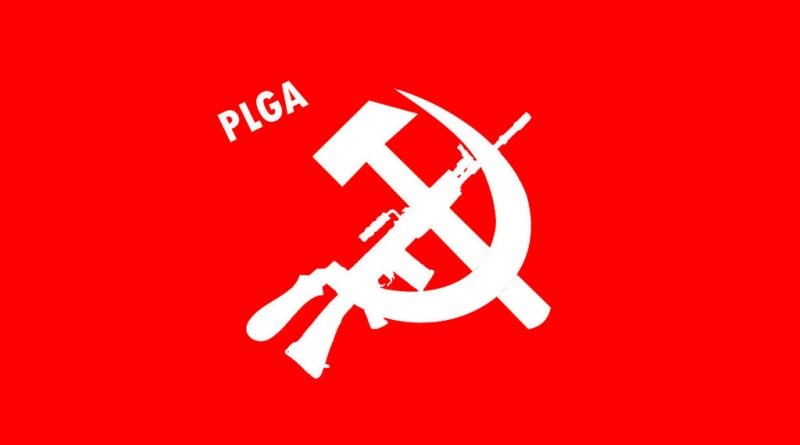
Courtesy – Redspark
The “Naxalites” we refer to today mostly have their roots connected to the Communist Party of India (Maoist).
What does CPI (Maoist) consists of?
The CPI (Maoist) consists of various groups and departments for its functioning. It has assassination and guerilla squads (part of PLGA), intelligence team, communications team, publishing team “Jung”, and many more.
What is Peoples Liberation Guerrilla Army (PLGA)?
PLGA or Peoples Liberation Guerrilla Army is an armed wing of CPI (Maoist) that is trained in the extreme form of violence and creating terror among people. As a result, their primary objective is armed conflict and mass mobilization. They use false narratives to influence people and convince them to join their cause of armed struggle.
What are Front Organizations?
The Front Organizations are part of the CPI (Maoist) organization. They are considered to be an underground unit that recruits people for armed struggle, raise funds to aid their war, provide shelter to cadres, take care of any legal situations, and much more.
Killing Civilians and damaging infrastructure
In order to maintain control, the Maoists/Naxalites don’t shy away from killing civilians. In a nutshell, if somebody does not adhere to their ideology or if the Maoists/Naxalites think that any person could be a threat and leaking information to government authorities, they eliminate him/her. This keeps them isolated from government hunt and also creates terror among people.
One of the objectives of the Maoists/Naxalites is to damage the infrastructure. They blow up schools, railway tracks, government offices, police stations, etc. The motive of blowing up schools and educational institutions is to deprive the rural population of any education because that would create a threat for the Naxals in the future. Damaging infrastructure is something that helps them keep the rural population away from developing India thereby keeping them under control.
Children and Women
Maoists/Naxalites brainwash and recruit children convincing them that they will be fighting for a great cause. The women are recruited after threatening them and their families. The women and children act as a shield when fighting with government forces. Recent reports have stated that women are being exploited and even raped by the male cadres of the organization.
Maoism and Naxalism (Maoists and Naxalites)
The terms Maoism and Naxalism have been used interchangeably in India for years and it is true to a certain extent. As discussed in the above sections, there is a slight difference between the two but the core objectives behind both have been the same.
The term Naxalism comes from the uprising in Naxalbari in 1967 that was initiated by peasants, working-class, and tribals with the help of leaders of the Communist Party of India (Marxist-Leninist) to end the feudalism and exploitation by the landlords.
Maoism, on the other hand, is the philosophy of the revolutionary leader of China, Mao Zedong, and is an extension of the theory of Marxism-Leninism.
Inherently, both Naxalism and Maoism are aimed at bringing about the proletariat revolution. Both aim to overthrow the imperialist powers and end Capitalism. Today, Naxalites (Maoists) of India reject the electoral process, aim to overthrow the government of India and bring about proletariat dictatorship through violent means. The Communist Party of India (Maoist) is the biggest and the most active Naxalite/Maoist group in India. Though Naxalism started as a movement to fight for the poor, peasants, wage workers, tribals, and the landless, it slowly converted into something that was terror-based and unlawful. That is why Naxalites are tagged as a part of the terror outfit today.
Naxalites and the Indian Government
Why Naxals have no faith in the government?
Today, millions of people provide support to the Naxalites. These include tribes, peasants, wage workers, and other poor sections of the society. Over the years they have been ill-treated and exploited. Factors like feudalism and untouchability have added to the misery.
They lack basic necessities like education and health, and they have been expelled from their own lands.
Lack of government institutions, legal aid, and justice are some of the other factors that have made people lose faith in the government. The Naxalites have taken this opportunity to increase their supporter base. They have created their own judicial system and people’s courts that provide quick judgment.
In 2013, a report showed that the Indian Government did not have proper data like the child mortality rate of the scheduled tribes. This shows ignorance on the part of the government. The other major factor has been that much of the land that is inhabited by the tribes is rich in coal and iron ore and they have been exploited and displaced by the private companies with the mining contracts. Due to this, a rise in the Naxalites insurgency is seen in the states (Chhattisgarh, Jharkhand, Odisha, etc.) where coal and other reserves are available.
The other side of the story is that Naxalites have been using unlawful means to achieve their objectives. They have killed people and paramilitary personnel; blown up buildings, schools, and railway tracks; extorted money from people, and opposed any move of the government that could help the tribes and poor class. In a way, the Naxalites have moved away from their core objective of genuinely standing up for the marginalized and it seems that they are now fighting their own separate war with the government.
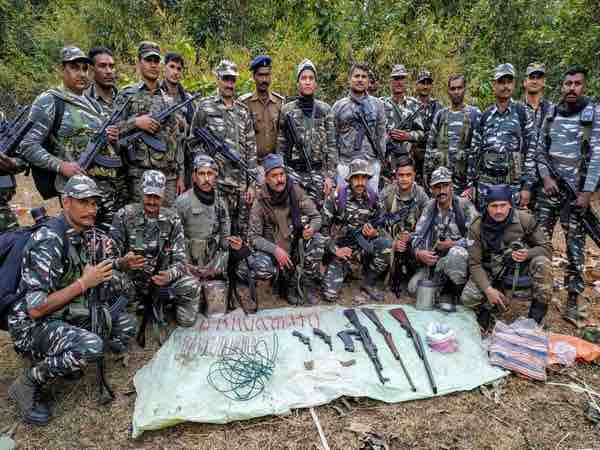
Courtesy – ANI News
What has government done?
It is not that no help has been provided by the Indian Government. The government has introduced schemes and plans to provide jobs to the weaker and poor sections and have also encouraged them to join politics. The Bahujan Samaj Party (BSP), a national-level political party, is based on the ideology of fighting for the rights of scheduled caste and scheduled tribes.
Slowly, as the education system is penetrating the rural areas, the youth has become more aware of the laws and what is right and what is wrong. They have started to move to the cities for better education and job opportunities thus weakening the Naxalite movement to an extent. Various schemes to enhance the infrastructure in rural regions are being implemented. The government is also working on enhancing security in the rural areas to combat Naxalites.
A special unit of CAPF, CoBRA (Commando Battalion for Resolute Action) which is trained to tackle guerrilla warfare has been deployed in the Naxalite affected regions.
As per the recent reports, Naxalites were once operational in around 200 districts of India, but today they have been reduced to 60 districts. Their presence is mainly in the states of Odisha, Jharkhand, Chhattisgarh, Bihar, Andhra Pradesh, Madhya Pradesh, Maharashtra, Uttar Pradesh, and West Bengal. As per the information, the Naxalites are planning to further establish their base in Kerala, Tamil Nadu, and Karnataka.
Fatalities due to Naxalites Violence
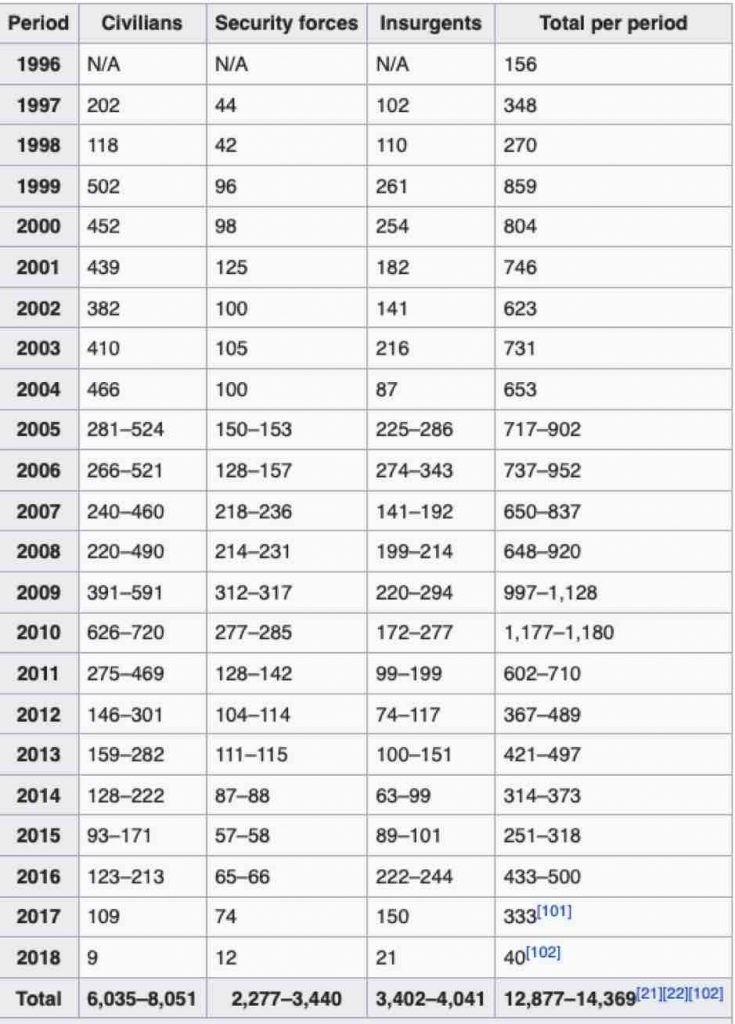
Courtesy – Wikipedia
Good Reads and References
CURATED & WRITTEN BY
AYUSH PANDYA
(AUTHOR- THE UNPRECEDENTED CULT)